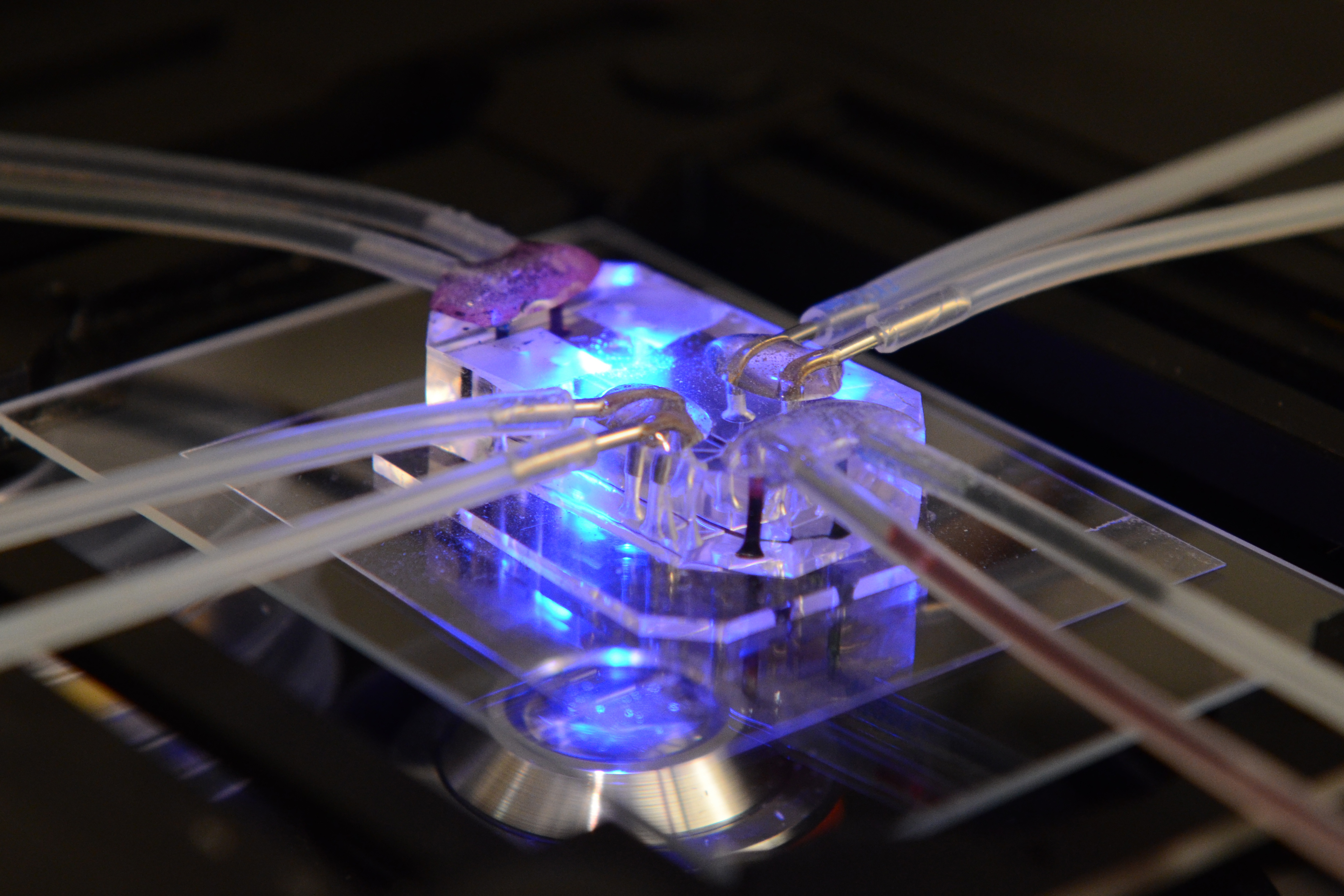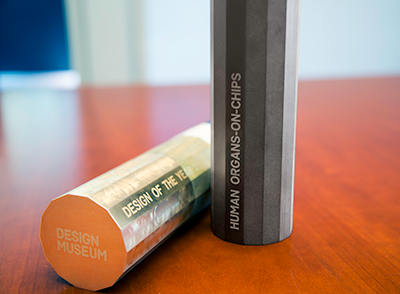(BOSTON) — The Wyss Institute’s human organs-on-chips, represented by the human lung, gut and liver chips, have won the overall Design of the Year 2015 Award, which is the United Kingdoms most prestigious design award. The honor was revealed during the annual Design of the Year awards ceremony, held on the evening of June 22 at the Design Museum of London, which marked the culmination of the 8th annual awards and museum exhibition.
“This winning design is a great example of how design is a collaborative practice embracing expertise and know how across disciplines. Its selection as Design of the Year 2015 also signifies a desire to recognize and award design that can significantly impact society now and in the future,” said Gemma Curtin, who is the Designs of the Year 2015 exhibition curator.

The ceremony not only named human organs-on-chips as the overall winner but also as the winner of the Product design category, in addition to honoring other winners who received awards representing five other design categories including Architecture, Digital, Fashion, Graphics, and Transport. Selected from an initial group of 76 nominees chosen by top design experts, practitioners, curators and academics to represent the world’s most innovative, high-impact, and forward-thinking designs, the category winners had comprised six finalists that were evaluated for the overall award by a jury chaired by the artist Anish Kapoor.
Human organs-on-chips received their nomination from Paola Antonelli, the Museum of Modern Arts Senior Curator of Architecture & Design and Director of R&D. “This is the epitome of design innovation – elegantly beautiful form, arresting concept and pioneering application,” said Antonelli.
Wyss Institute Senior Staff Scientist Anthony Bahinski, Ph.D., MBA, FAHA, who has been instrumental to the development and translation of the technology, attended the awards ceremony and accepted the Product and Design of the Year awards on behalf of Wyss Founding Director Donald E. Ingber, M.D., Ph.D., and former Wyss Technology Development Fellow Dan Dongeun Huh, Ph.D., who collaborated and first designed the initial human organ-on-a-chip in 2010.
Ingber – whose earliest scientific work led to the discovery that tensegrity architecture, first described by architect Buckminster Fuller and sculptor Kenneth Snelson, is a fundamental design principle that controls how biological systems are structured – founded the Wyss Institute for Biologically Inspired Engineering in 2009 with the mission to draw inspiration from the way Nature builds to develop innovative bioinspired technologies that improve human health and the environment.
“This is an extremely meaningful moment, as the intersection of science and design has been a constant source of inspiration throughout my career,” said Ingber. “To have the microscopic elegance and function of human organs-on-chips recognized in an international design forum is a powerful testament to the breadth and depth at which design principles contribute to biological function as well as technological advancement, and it is a recognition for which I am deeply honored to receive on behalf of the Wyss Institute.”
Since Ingber and Huh initially designed the first organ-on-a-chip, the lung-on-a-chip, several additional human organs-on-chips have been developed at the Institute thanks to the efforts of a multidisciplinary team of Wyss scientists. The microdevices have the potential ability to deliver transformative change to pharmaceutical development and human healthcare due to the accuracy at which they emulate human organ-level functions. They stand to significantly reduce the need for animal testing by providing a faster, less expensive, less controversial and accurate means to predict whether new drug compounds will be successful in human clinical trials. To achieve the ultimate goal of translating the technology, the startup company Emulate, Inc., sprang out of the Wyss Institute in 2014 to commercialize human organs-on-chips.
Human organs-on-chips are built using an innovative microfabrication process adapted from the computer chip industry, in which photolithography is used to manufacture memory-stick-sized blocks of crystal-clear, flexible rubber that contain hollow microchannels. These microchannels are then lined with living organ cells and blood capillary cells under fluid flow and manipulated mechanically using vacuum-powered movements to replicate organ movements.

“One of the most important things about the Designs of the Year award is the chance that it gives the museum to explore new territory,” said Deyan Sudjic, who is the Director of the Design Museum. “The team of scientists that produced this remarkable object dont come from a conventional design background. But what they have done is clearly a brilliant piece of design. They identified a serious problem – how do we predict how human cells will behave – and they solved it with elegance and economy of means, putting technology from apparently unrelated fields to work in new ways. They have perhaps unintentionally created something that for a lay man seems to symbolize the essence of life and also happens to be beautiful to look at.”
As the 2015 recipient of the Design of the Year Award, the human organs-on-chips design is the latest winner in the annual award series. The human organs-on-chips and 75 other overall 2015 nominees are currently on display in the Designs of the Year Awards Exhibition at the Design Museum in London, which will remain open until March 31, 2016.
The 2015 design category winners are:
- Architecture: UC INNOVATION CENTER – ANACLETO ANGELINI by Elemental
- Digital: THE OCEAN CLEANUP by Boyan Slat, Jan de Sonneville PhD and Erwin Zwart
- Fashion: THOMAS TAIT AW13/14 by Thomas Tait
- Graphics: INGLORIOUS FRUITS & VEGETABLES by Marcel for Intermarché
- Product: HUMAN ORGANS-ON-CHIPS by Donald Ingber and Dan Dongeun Huh
- Transport: GOOGLE SELF-DRIVING-CAR by YooJung Ahn, Jared Gross and Philipp Haban
Previous winners of the Design of the Year awards have been:
- 2014: Heydar Aliyev Center by Zaha Hadid Architects
- 2013: GOV.UK – UK Government website by GDS
- 2012: London 2012 Olympic Torch by Edward Barber and Jay Osgerby
- 2011: Plumen 001 by Samuel Wilkinson and Hulger
- 2010: Folding Plug by Min-Kyu Choi
- 2009: Barack Obama Poster by Shepard Fairey
- 2008: One Laptop Per Child by Yves Béhar
